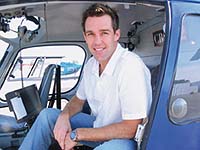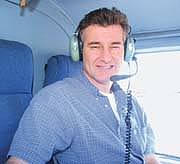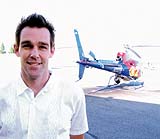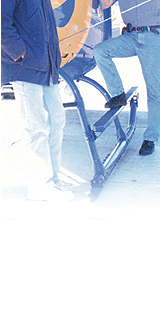Local
45 Members Have Room With A View
April 2004 IBEW
Journal
In todays 24-hour news environment,
the pressure is always on to get the news of the moment
out the fastest. And when local news breaks in Southern
California, it is often the images collected by helicopter
camera operators that hit the airwaves first.
A combination of sprawling geography and highway gridlock
make the presence of news helicopters crucial in the
60-city megalopolis that comprises the greater Los Angeles
area. The best of those airborne camera-wielding professionals
are represented by IBEW Local 45, Hollywood, California,
which has contracts with some of the biggest television
stations in the state.
"Helicopters are a very important part of the
news business here," said Local 45 Business Manager
Lloyd Webster. "On every story, the choppers are
there, right away."
With a 1,000-square-mile coverage area that includes
Los Angeles, Ventura, Orange and Riverside counties,
helicopters have the advantage of getting the news bestwith
great visualsas well as getting it first. This part
of Southern California is the biggest and most sophisticated
helicopter news market in the country.

Aaron Fitzgerald
"We usually get a couple of live helicopter reports
by the time the ground crews get there," said Aaron
Fitzgerald, who works as a cameraman/reporter for KCBS
and KCAL, both owned by Viacom.
Often, they even beat responding fire and police departments,
said KCAL helicopter cameraman Chris Torgerson.
California news is more than O.J. Simpson-style freeway
police chases and traffic gridlock, although it does
still have its share of both. "A very small percentage
of what we do are the car chases, but its a cultural
phenomenon out here," Fitzgerald said. "Well
also cover shootings, flooding, fireanything you would
see on the news. On the other hand, there are stories
than can only be covered by helicopter."
Fitzgerald cited natural disasters that restrict travel
in an area, like the brush fires that ravaged mountainside
communities last year. Nothing can match an aerial view
in providing perspective to a story. Although they may
appear to the viewer to be close to the action, the
helicopters remain between 1,000 and 1,500 feet above
ground.
During newscasts, Fitzgerald said, he and the helicopter
pilot usually remain in the air, "cruising,"
ready to respond to a breaking news event. They listen
to police and emergency scanners and rely on a network
of official spokespersons and sources in the fire and
police departments.
Pressure to be the first on the air with news pictures
from the latest scene drives the highly competitive
business. All the crews strive for that first "exclusive"
shot from a scene. And no one wants to be the last helicopter
to arrive.
"When you fly around in an expensive machine,
you want to feel youre delivering the goods,"
Torgerson said.
Fitzgerald said KCBS and KCAL have the advantage of
being based out of an airport miles from the one the
other networks use. "It helps us sneak around"
without notice, he said.
At KCAL, Torgerson said he uses between six and nine
police, fire and emergency scanners monitoring more
than 1,000 channels. Last October, the brush fires tested
the endurance and skill of the helicopter crews, Togerson
said. He and the pilot/reporter that comprise their
two-man team commonly worked intense 12-hours shifts.
"The mental acuity it takes to run a camera and
navigate and juggle the different instrumentation takes
a lot out of you," Torgerson said. "If youre
flying more than four hours a day, thats a lot of flying."
Torgerson said the A-Star helicopter he flies in, which
was built as a six-seater, only has room enough for
two because it is loaded with heavy newsgathering equipment
vital to his work. The ship travels around 105 miles
per hour. Most news helicopters in Los Angeles contain
two-man crews with one pulling double dutyeither a
reporter/pilot and a cameraman or a pilot and a reporter/cameraman.

Gil
Leyvas
But a job that involves floating over crime scenes
or disasters can be dangerous, especially when as many
as 10 choppers are covering the same event. That does
not include police helicopters also tracking an unfolding
scene from the air. Usually, Torgerson said, law enforcement
aircraft fly several hundred feet closer to the ground.
The main concern for pilots is keeping tabs on the other
helicopters occupying the same "level" or
altitude. Thats why constant radio communication among
pilots is vital. "Everybody coordinates with everyone
else to make it as safe as possible," Torgerson
said.
Recently, when he was hovering over a police standoff
involving a man with a rifle, Fitzgerald said the armed
man started shooting at the helicopters. Luckily, even
though the footage captured by helicopter photographers
looks close to the action, its generally due to a powerful
zoom lens. So from the ground, "its very hard
to hit a helicopter," 1,000 feet in the air.
A bullet did hit the rear tail stabilizer of the ship
Torgerson was in when he delivered footage of a massive
1997 standoff between two bank robbers and hundreds
of police in North Hollywood. Fortunately, the bullet
had no impact on the helicopters ability to fly; the
crew did not even discover the damage until days after
the event. On live national television, he managed to
capture the unfolding ordeal as the scene devolved into
a shootout between the police and robbers. Several police
were injured in the confrontation that ended after one
robber was killed and the other turned his gun on himself.
Weather conditions can cause helicopters trouble. Among
the worst are fog and high winds.
Many helicopter crews tell of near-disasters involving
equipment malfunction or engine failure. But despite
the danger, all spoke highly of the experienced pilots
they work with and were philosophical about the dangerous
potential of their work sites.
"Aviation in general is unforgiving when you make
mistakes," said Fitzgerald, a former paratrooper
with the 82nd Airborne who is also a helicopter pilot
in his spare time.
 Webster
said Fitzgeralds bravery and quick thinking during
a chopper crash earned him a lifesaver award from Local
45. While he and several other helicopter crews were
covering the Academy Awards, another helicopter ran
into technical difficulties. Keeping in constant radio
contact, Fitzgeralds pilot accompanied the troubled
ship back to the airport. Before landing, a loss of
hydraulics caused the helicopter to drop 50 feet onto
the ground. The pilot managed to escape but the camera
operator was still on board as the ruptured gas tank
caught fire. Webster
said Fitzgeralds bravery and quick thinking during
a chopper crash earned him a lifesaver award from Local
45. While he and several other helicopter crews were
covering the Academy Awards, another helicopter ran
into technical difficulties. Keeping in constant radio
contact, Fitzgeralds pilot accompanied the troubled
ship back to the airport. Before landing, a loss of
hydraulics caused the helicopter to drop 50 feet onto
the ground. The pilot managed to escape but the camera
operator was still on board as the ruptured gas tank
caught fire.
"It was very traumatic to watch it and know that
two of your friends are on board," said Fitzgerald,
who risked his own life to pull his colleague to safety.
The adventure turned deadly for a former Local 45 member
and KCBS reporter who was aboard a helicopter that crashed
into the Persian Gulf off the coast of Iran in 2002.
Shop steward and award-winning cameraman Larry Greene
died when the rotor blade of a military helicopter he
was riding in clipped the mast of a freighter and plunged
into the sea.
With their birds eye view of life, "the perspective
is very, very different," Fitzgerald said. "Eight
out of ten people cant find their own house from that
view point."

|


